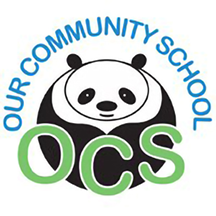Bullying and Harassment Prevention
No-one Eats Alone!
No-one Eats Alone! Is a
fun-filled, special day where every student is asked to find someone to
each lunch with, someone with whom they do not normally sit. Our 8th
grade students help facilitate conversations and games, showing students
that it is okay to sit with different people, and that we can always
find common ground. Differences are celebrated and students are able to
share experiences in a non-threatening way that helps reduce bullying
and harassing incidents.
Parent volunteers help set up our lunch
area, and help kids create leaves that share ways to be kind to others.
The leaves are attached to a giant paper tree and flowers to be used
throughout the years.
Peaceful Learning Communities
Peaceful Learning Communities are used in our classrooms to bring to light any issues that students may have with one another. PLCs are teacher-facilitated, but are student-driven. Students are able to share their feelings and the class as a whole is able to dig deeper into why certain things are occurring, and what alternatives can be taken to prevent certain things from continuing. PLCs reinforce our belief that student voice matters, and that students need to be the creators of solutions that benefit everyone. PLCs are known to have a positive effect on reducing the number of bullying and harassing incidents.
Different Types of Bullying
We believe it is important for student and parents to understand what “bullying” means. Often the term is thrown at people without its true definition being applicable. There is a difference between a child saying something mean, as children sometimes do, and a child bullying another. During Advisory and Morning Meetings, different types of bullying are defined and shared about. Technology class also dives deeper in cyber-bullying.
- Physical Bullying
This is what most of us think of when we hear the word bullying. All of those images in our heads of fights on the playground, or scuffles in the hallway between classes fall under this category. It includes: hitting, pushing, tripping, slapping, stealing or destroying possessions, and sexual harassment or assault. - Verbal Bullying
Verbal bullying can be just as damaging as physical bullying. Females typically engage more in this form of bullying, though males may also use it in an attempt to dominate their victim. Kinds of verbal bullying include: name calling, insults, gossip, teasing, taunting, intimidation, and sexist or racist remarks. - Social Bullying
Sometimes called indirect or covert bullying, this form can be more difficult to detect. It can go on behind the victim’s back, or can take the form of public humiliation. It includes: spreading rumors, non-inclusion, negative gestures, jokes or pranks, embarrassment or humiliation, and damaging someone’s social reputation. This form can be the most emotionally damaging to its victims, and may cause them to experience depression and anxiety. The psychological effects of social bullying often stick around even into adulthood. - Cyberbullying
Due to the internet, social media and smart phones, cyberbullying has rapidly increased among today’s youth. It takes place over digital devices such as cell phones, computers and tablets and can occur through SMS, text, apps, social media, chat rooms, gaming, etc. It reaches the victim wherever they are, and they often feel that they cannot escape.

